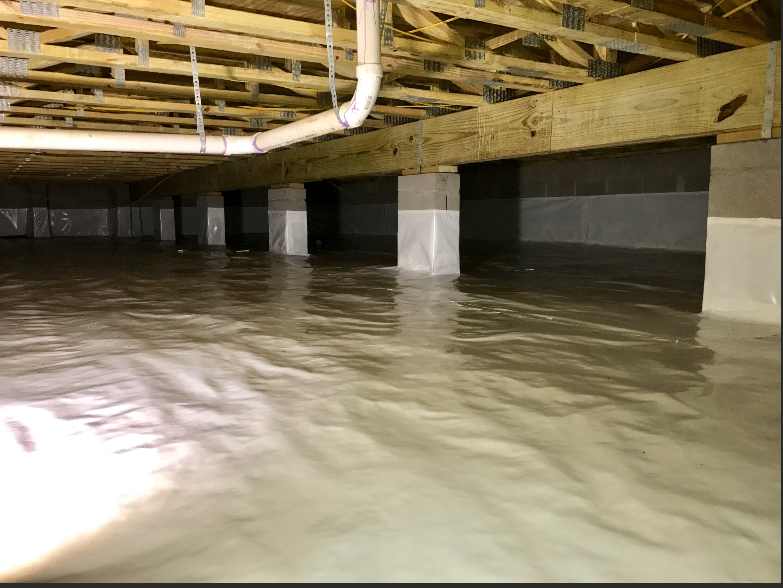Dehumidifying Sealed Crawlspaces

By: Reggie Hucks | Jun 03, 2020
Its 95 degrees on a hot, humid day. A service repairman, working on your HVAC, opens the door to your vented crawlspace. He observes ductwork dripping with water, mold on floor joist, and termite tunnels on the crawlspace walls. He services your air conditioner and recommends you call an exterminator. Why are you having all these issues in your crawlspace? Could it be that the naturally vented crawlspace doesn’t work anymore? Some people would say, it never worked. Why is this?
Traditional Vented Crawlspaces
Homes have been built on vented crawlspaces for over one hundred years. This design was fine when homes were drafty and had little insulation. In areas with low humidity levels, vented crawlspaces are still okay. But in the south and similar climates, vented crawlspaces can be quite troublesome. It all has to do with moisture in the air. As air is drawn into the crawlspace, the ambient temperature drops. If the humidity in the air is high, moisture will collect on floor members, crawlspace walls, and ductwork. A combination of organic material (wood) and water creates the perfect environment for mold growth. Termites need water and organic material to thrive as well. In certain geographical locations, crawlspaces are rich environments for termites and mold most of the summer. So, what can we do to prevent these problems? How about a sealed crawlspace?
The Sealed Crawlspace
The sealed crawlspace can be the answer to the moisture problems associated with vented crawlspaces. In a sealed crawlspace, there are no vents. Insulation can be installed in the floor or on the perimeter walls. Heavy plastic liners are placed on the crawlspace walls and ground. Still, through infiltration, air is trapped in a sealed crawlspace. Moisture in the air must be dehumidified. Once dehumidified, the crawlspace can be a dry, cool environment that does not promote mold growth or termite infestations. As air slowly infiltrates, the dehumidification can control the moisture. The question is, what method should be used to dry the air? There are a variety of ways to do this, all having strengths and weaknesses.
Treating the Crawlspace as a Conditioned Space
This method treats the crawlspace as if it were another room in the house. The crawlspace wall insulation must meet the R factor of a standard house wall or whatever is required by the jurisdiction’s energy code. In this scenario, air can be returned from the crawlspace and conditioned air supplied to it. The downside is the possibility that contaminants are in the crawlspace environment. Termite treatments are typically applied to the soil around the house foundation. Some areas of the country are rich in radon gas. Freely communicating air between the crawlspace and the home might not be the best method based on these factors.
Supplying Conditioned Air to the Crawlspace
With this system, air is supplied to the crawlspace by a supply duct from the house’s A/C system. A backflow damper is installed in the duct to minimize back drafts. The supply air pressurizes the space and relies on exfiltration or an exhaust vent to relieve air pressure. While this can work, there is the possibility that crawlspace air enters the home if the damper malfunctions. Furthermore, determining the right amount of dehumidification (supply air) can be calculated but not precisely controlled. An upside is the low cost of equipment required for dehumidifying the space.
Installing an Exhaust Fan
Simply installing an exhaust fan and allowing infiltration for makeup air is a method recognized by most building codes. The fan must be capable of moving 1 cubic foot per minute (CFM) of air per 50 square feet of space. While this method can work, excess moisture could be drawn into the crawlspace, which can be counterproductive. This is probably not the best system for areas with high humidity.
Installing a Dehumidifier
The final method discussed here is probably the most reliable. Installing a dehumidifier, capable of removing the crawlspace moisture, will almost guarantee a cool, dry environment that promotes the life of the structure. A humidistat can precisely control the moisture content in the air to the desired humidity level. Just remember, the dehumidifier will require a drain to channel water to the exterior. It will also need to be serviced at least annually. The downside is cost and maintenance, but this method is the most foolproof of all these listed.
If installing crawlspaces requires a sealed system with dehumidification, why bother? After all, many homes are built on concrete slabs. Basically, a crawlspace provides easy access to plumbing, electrical, or any other system routed underneath a house. If systems must be replaced later, it’s cheaper to do in a crawlspace than a house built on a concrete slab. If the crawlspace is sealed and dehumidified, a whole lot of problems will be avoided, making home ownership much more enjoyable.

